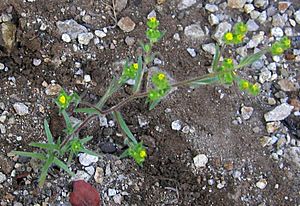Small tarweed facts for kids
Quick facts for kids Small tarweed |
|
|---|---|
 |
|
| Scientific classification | |
| Kingdom: | |
| (unranked): | |
| (unranked): | |
| (unranked): | |
| Order: | |
| Family: | |
| Genus: |
Madia
|
| Species: |
M. exigua
|
| Binomial name | |
| Madia exigua (Sm.) A.Gray
|
|
Madia exigua, also known as small tarweed or threadstem madia, is a type of flowering plant. It belongs to the aster family, which includes many well-known flowers like sunflowers and daisies. This plant is known for its unique scent.
Where It Lives
Madia exigua is found in western North America. Its home stretches from British Columbia in Canada all the way down to Baja California in Mexico. You can find it growing in many different kinds of dry places. It prefers areas that are not deserts.
What It Looks Like
Madia exigua is an annual herb. This means it lives for only one year. It can grow up to about half a meter (20 inches) tall. Its stem is thin and covered with tiny hairs. It also has special sticky bumps called resin glands. Sometimes, it even has small bristles.
The leaves of this plant are rough to the touch. They are usually 1 to 4 centimeters (0.4 to 1.6 inches) long.
Its Flowers
The flowers of Madia exigua grow in groups. These groups are called flower heads. They sit on thin, stiff stalks. Each flower head has special leaves around it. These leaves are called phyllaries. They are shaped a bit like a spinning top. These phyllaries are also covered in sticky, yellow resin glands.
At the very top of the flower cluster, you'll find tiny yellow petals. These are called ray florets. They are less than a millimeter long. There are also one or two yellow disc florets in the center.
Seeds and Fruit
After the flowers bloom, the plant produces a small, dry fruit. This fruit is called an achene. It's similar to a sunflower seed. Unlike some other plants in the aster family, the achene of Madia exigua does not have a pappus. A pappus is a fluffy part that helps seeds fly away in the wind.

